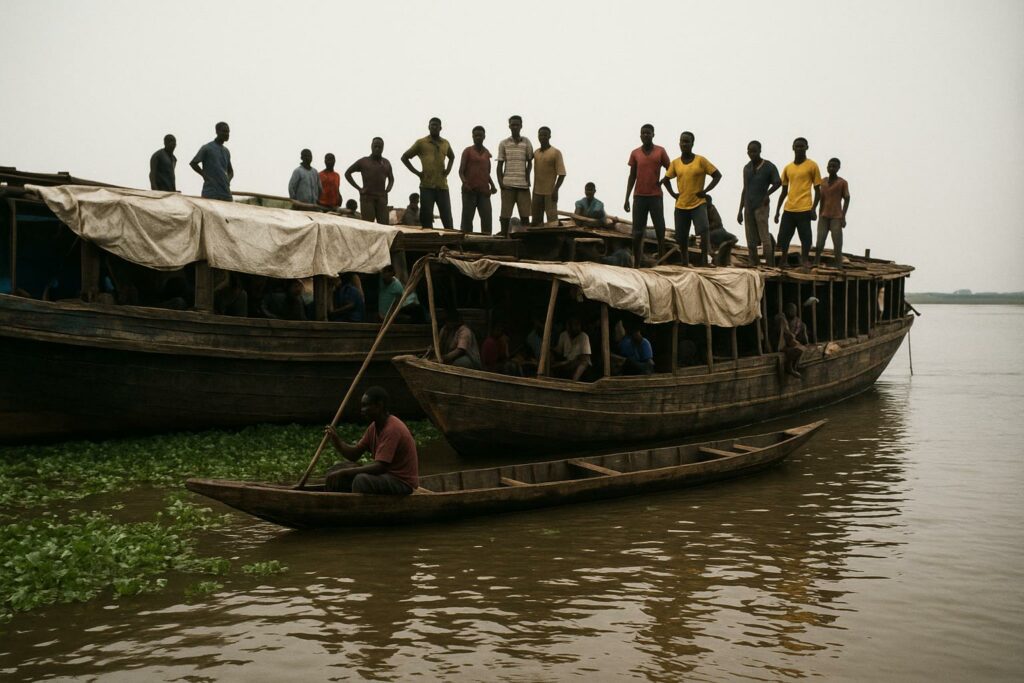Nighttime capsizing on the Lulonga River
Darkness had already settled over the dense equatorial canopy when a motorised barge laden with goods, livestock and scores of passengers lost stability on the Lulonga River, some 700 kilometres north of Kinshasa. Authorities report that the vessel, bound for the neighbouring Republic of the Congo, overturned on Tuesday night near the town of Basankusu. Around fifty-five individuals were hauled from the water by local fishermen and other travellers, yet an estimated 145 remain unaccounted for, their fate swallowed by the brown current.
Survivors’ accounts and initial tally
Jean-Pierre Wangela, who heads the regional civil-society network, told reporters that frantic head counts begun at daybreak on Wednesday quickly revealed the scale of the catastrophe. “We counted survivors one by one, but the lists of those who boarded showed many more names,” he explained, noting that exact manifests are rare for such river journeys. Provisional figures released by district administrators on Thursday converged on Wangela’s estimate, while stressing that verification is complicated by the constant movement of informal traders along the riverbanks.
Surcharged vessels and systemic vulnerabilities
The immediate cause cited by Wangela is overloading—a recurrent hazard on inland waterways where formal transport alternatives are either prohibitively expensive or altogether absent. In the province of Équateur, forest tracks become impassable during the rainy season and commercial flights are financially out of reach for most residents. Riverboats, therefore, act as floating markets, passenger vehicles and freight trucks at once. The resulting congestion of merchandise, rudimentary canoes hitched to hulls, and livestock tethered on deck stretches buoyancy limits beyond safety margins.
Cross-border lifelines and economic stakes
The ill-fated barge was reportedly headed toward trade posts on the opposite bank in the Republic of the Congo, underscoring the economic interdependence that binds the twin capitals of Brazzaville and Kinshasa and their hinterlands. Small-scale commerce in palm oil, cassava flour and timber relies heavily on night navigation to meet early-morning market hours. While cross-border links nurture livelihoods, they also amplify exposure to accidents, as captains race against curfews and fluctuating river depths to secure a competitive edge.
Emergency response under tight constraints
Rescue operations in the remote forest districts of the Democratic Republic of the Congo confront stark logistical hurdles. The nearest army patrol boat, according to local officials, is stationed several hundred kilometres downstream and can take days to arrive. Medical outposts in Basankusu possess limited supplies of anti-malarial drugs, let alone equipment for mass casualty events. In the absence of specialised divers or sonar, families have organised watch vigils along muddy banks, hoping bodies will surface naturally. Each passing hour, however, diminishes prospects of locating survivors.
Legal and governance outlook
National maritime regulations enacted in 2015 require passenger manifests, life jackets and daytime navigation for commercial craft, yet enforcement remains uneven outside major ports. Policymakers in Kinshasa have periodically announced river-safety campaigns—including mandatory inspection posts and public-awareness drives—but budgetary constraints and vast distances mean that compliance often rests on individual goodwill. Civil-society groups are urging renewed attention to decentralised infrastructure financing, arguing that modest investments in floating piers, radio beacons and community-run rescue brigades could significantly reduce the human toll without straining the state coffers.
A regional tragedy, a national reckoning
As the Lulonga River carries on its silent flow toward the mighty Congo, families in Basankusu recite names of missing relatives and light resin torches that flicker against the night sky. The disaster, while unfolding far from the capital’s spotlight, adds to a sobering ledger of inland-water incidents that periodically jar national conscience. Each accident revives a lingering question: can the promise of the river as a conduit of trade and unity be reconciled with the duty to safeguard every passenger who steps aboard? Until that balance is struck, the waters will continue to bear witness to both livelihoods sustained and lives abruptly lost.

